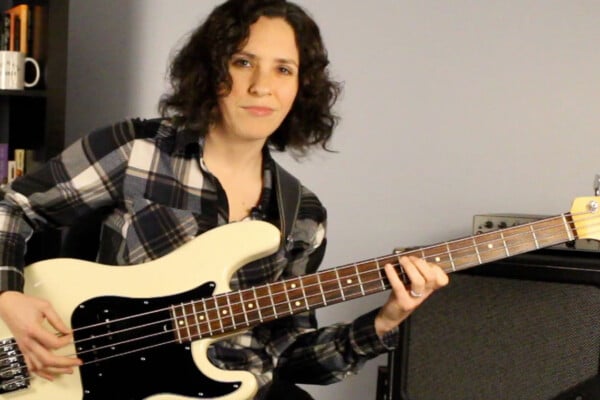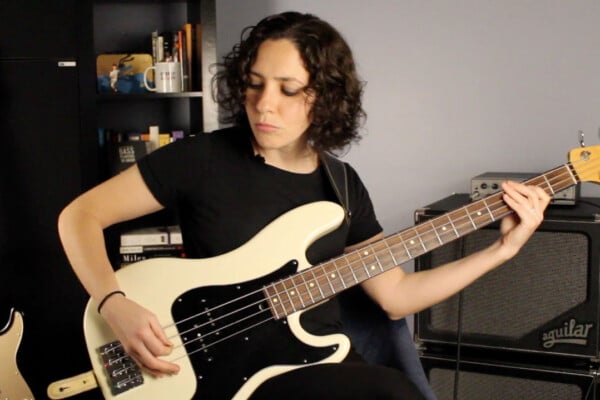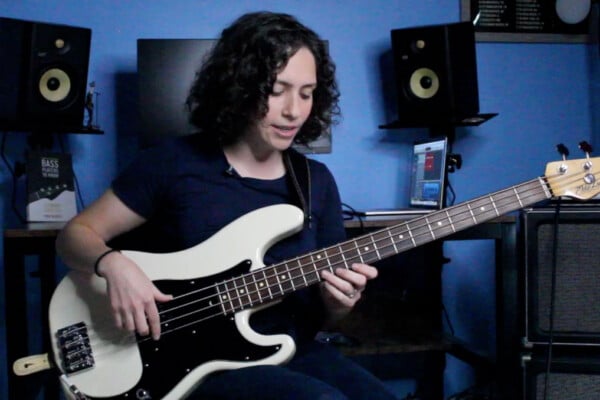Finger-Style Funk Bass Lesson: Build Dexterity and Accuracy in Your Playing
In this lesson we’re going to focus on a style known as finger-style funk (or “finger funk”), with the goal of developing both dexterity and accuracy in your playing.
Finger-style funk is typically centered around the 16th note, and many of the notes are muted. You’ll notice in the notation for this lesson that those muted notes are indicated with an “x” for the note head. The purpose of the muted notes is to create a continuous groove, with a strong 16th note feel.
This is style is reminiscent of Rocco Prestia, Jaco Pastorius and others. Although it sounds like a simple idea to play this piece, the physical execution is rather difficult. If you stick with it, you’ll get it!
Follow along with the notation. In the video, I’ll play it full speed and then show it again at progressively slower speeds.
Let me know how it goes!
Post your comments, videos of your finger-style funk playing and/or questions in the comments section. Or share your favorite 16th-note finger-style funk groove!




Went pretty well, in fact… this is one of the few things I can do well. Blame Rocco.
Nice, going to get right on it (although I’ll be playing it with a pick). Thanks for another great lesson, Grant!
Very cool. any chance you have more? A book maybe?
that guy, looks like my Kelly! Ryan Lynch!
Yes Gary, I have many more lessons like this. This is actually a promotional lesson for NoTreble, designed to show you what kind of lessons I make with Stinnett Music. Here is a link to where you can download many video lessons. http://www.e-junkie.com/stinnettmusic There are also some more free ones here on NoTreble, and some on YouTube. I am in the process of finishing a book called Tapestry, all about tapping on the bass. I am also writing another book at the moment called Slap Mastery.
hello, great lesson, do you have tab?
That was a lot of right hand pedaling. I hit the first tempo change speed ok, but top speed was tough.
Sick groove, Grant, thanks for slowing it down for us!
Hey Grant – that’s a cool lesson. Question: do you do the style of Left Hand ‘damping’ with 3rd and 4th fingers that Rocco does – or are you muting strings another way?
Hey there HTPB.com, with just four strings, it’s pretty simple. My thumb usually rests on the E string when I’m not using it, causing a muting effect. My plucking fingers automatically mute one string lower than I play, because they land on the next string. And my left hand technique is very close to the fingerboard, so the muting of the higher strings is natural when I am not playing them. I have known other players, whom I respect, using different techniques to stop ringing in the strings, but it has always just been rather natural for me.
Hey Grant – thanks for that. That’s pretty much how I mute as well. Paul
hey grant, great lesson. I have one that sound almost like it here: http://youtu.be/wBdLB0lbPoQ.
would you consider this a mixolydian thing or natural minor considering you’ve got an F# and G at one point?
great playing and tone, ill be practicing this one.
peace out.
Good line, sounds a bit like you’re fighting the groove the groove though. Feels like it should be more behind the beat? Good lesson though.
Excellent lesson, especially getting those 1/16th notes smooth! I think I’m at 65 bpm so far :)
Hey Grant love the lesson! Is there any chance I can get the other riff played during the introduction to complete the song? It sounds incredible, keep up the great work….
cool
I know this was posted a while ago but I ‘d like to know what type strings are being used. Thanks for the repost